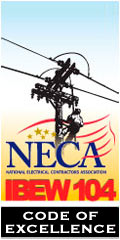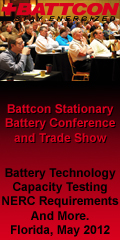NEPPA eNewsletter
April 2012
|
Robert Bryce, one of America’s most prominent energy journalists, thinks that claims being made about our energy future are simply wrong – that renewable sources and wind and solar in particular – are not "green" and cannot provide the scale of energy that the world demands. "We cannot, and will not, quit using carbon-based fuels at any time in the near future for a simple reason," Bryce says. "They provide the power that we crave." Bryce, an author/journalist, will lead the speaking program at NEPPA’s 2012 Annual Conference, Sept. 16-19 at the Sunday River Resort, Bethel Maine. He is a senior fellow at the Manhattan Institute and lives in Austin, Texas. His articles have appeared in numerous publications ranging from the Wall Street Journal and New York Times to National Review and Counterpunch. He is the author of four books on energy including, most recently, Power Hungry: The Myths of "Green" Energy and the Real Fuels of the Future. A review in the Wall Street Journal called the book "unsentimental, unsparing and impassioned; and, if you'll excuse the pun, it is precisely the kind of journalism we need to hold truth to power." Bryce is one of several speakers who will address the controversy around energy fuels of the future and a point/counterpoint session will follow their presentations. "This year’s conference promises to be exceptionally lively and informative," said NEPPA Executive Director Larry Brownell, "and the relaxing and invigorating setting at Sunday River can’t be beat." Watch your mail later this month for preliminary details on the conference. ##SHARELINKS##
|
|
NEPPA’s hill visit this year was more like a Seal Team 6 mission. Traditionally NEPPA has a large contingent from our states and we are marshaled by the great leadership of Sharon Staz and the folks of Morgan Meguire, but because the rally was moved to March this year our member attendance was slightly down. Unfortunately, our fearless commander (Sharon) was not able to attend either. This left NEPPA with a small but strong contingent. We were stealthily guided from meeting to meeting by the good folks at Morgan Meguire and overall the sessions were very successful. This year there was not an immediate fire for us to bring to our meetings so we focused on very important issues which included: · Financing Clean Energy and Infrastructure · Cyber Security · Hydropower Reform · Dodd-Frank · Transmission Incentive Rates · LIHEAP Appropriations We were well prepared. Sharon and Morgan Meguire conducted several conference calls leading up to the event to hone our messages and we conducted our traditional breakfast briefing before everyone took to the hill. We began by attending the APPA L & R Committee (chaired by our Barbara Grimes). At the meeting we seconded and co-sponsored a motion on a resolution addressing transmission rate incentives. NEPPA has long been a proponent of the positions that were put forth in the draft. We continue to promote our positions on incentives in our legislative meetings and meetings with the FERC Commissioners. Three of our contingent met with new Commissioner Cheryl LaFleur and Vinnie Cameron participated in meetings with Commissioners John Norris and Phil Moeller. Our small contingent was able to meet with 12 Massachusetts congressional officers including an in-person with Senator Brown. Mike Kirkwood was able to meet with both senators and house reps from Rhode Island and I was lucky enough to accompany him on two of these meetings. Mike may have missed his calling. His comfort and skill at communication with the Rhode Island leaders was quite impressive. Judy Gove was equally successful and skilled with the New Hampshire leaders – meeting with Sens. Kelly Ayotte and Jeanne Shaheen, as well as staff to Rep. Frank Quinta and Charlie Bass, a key member of the energy and commerce committee. I believe that all our meetings were quite successful and that we have motivated some movement on our key issues. I would like to thank all of our member participants and encourage everyone to consider participating in 2013. Our issues are slightly different from those of different regions of the country and unless we continue to communicate with legislators and regulators they will not understand our needs. I would also like to strongly encourage all of the New England groups to participate as one community. It is crucial to our efforts that we appear unified and that we minimize side issues when we conduct our visits. I encourage groups with additional issues to schedule visits at different times of the year or when our leaders are back in their communities to address separate topics. This will keep public power on their radar and reduce any conflicting messages during our once-a-year rally. What we do every year in DC is important and impacts public power in the Northeast. If you are a leader at your utility or in the industry, you should get involved. ##SHARELINKS##
|
|
Belmont Town Meeting unanimously passed an article authorizing the Belmont Municipal Light Department (BMLD) to purchase land and bond the financing for the construction of a new substation and transmission line that will address Belmont’s electric needs for the next 40 years. The utility is in the process of developing a list of potential transmission owners, including but not limited to NSTAR, to be canvassed for solicitation of proposals to build a new transmission line into Belmont’s new substation. BMLD has also signed a Purchase and Sales Agreement (P&S) for the new substation site and the sale deposit is pending final legal work such as clearing of the title in preparation for closing. A full site inspection related to the P&S is also currently underway. BMLD is also working with the MBTA regarding necessary easements to run the new line along railroad tracks. Meanwhile BMLD is working closely with town officials and the town treasurer to prepare the first Bond Anticipatory Note (BAN) for project costs. Bonding for the substation project will be done in stages as necessary to fulfill obligations of the project. Anticipated rate increases will be enacted for all BMLD customers to meet its obligations to the financing of the substation project beginning April 1, 2013. While final calculations have not been completed, all customers should plan on a rate increase of 14%. ##SHARELINKS##
|
|
Bob Jolly will be retiring from his position as general manager of the Marblehead Municipal Light Department on April 13, 2012, after 33 years of service. He began his career at the utility as a lineworker and worked his way up to general manager. He spent many years on the NEPPA board and served as secretary to the organization. His position on the board will be filled pending nomination submissions. Michael Cloutier from Groveland Municipal Light Department will fill the position as Board secretary. ##SHARELINKS##
|
|
April 11-13 2012 Public Utility Management Program Cranwell Conference Center, Lenox, Mass. It's not too late to sign up for this valuable program. June 6 Customer Service Conference 2012 Gillette Stadium, Foxboro, Mass. Mark your calendars and don't miss out on this fantastic venue with quality speakers and a tour of the stadium. This isn't just for CS reps. Watch your mail for info. later this month. June 15, 2012 Sept. 16-19, 2012 ##SHARELINKS##
|
|
As I travel through the NEPPA service area and talk with many line crews all across New England I find that very few line crews are grounding de-energized electric distribution lines for employee protection. Utility crews more often choose to use the OSHA-approved method of treating the de-energized lines as though they were still energized. But with human nature being what it is, are those crews really treating those de-energized lines with the same respect they would have for energized lines? Are they working in the safest manner? OSHA believes that transmission and distribution systems are different from other energy sources found in general industry. The transmission and distribution lines and associated equipment are constructed outdoors and could possibly be re-energized by various means. An automobile accident near the jobsite could bring an energized conductor in contact with a de-energized line. A de-energized line could become energized by a lightning strike. It has been reported to me that one such event actually injured a lineworker in Maine a few years ago, which means that it can happen. Also, the "human error" factor will always be with us and lines that were supposed to be de-energized accidentally became re-energized. One of the advantages seen by lineworkers (removing their rubber gloves) of grounding overhead electric lines was taken away with the advent of the "Ground to Ground Rubber Glove Rule". This rule requires that appropriate insulated rubber gloves be worn whenever a lineworker ascends a pole or his bucket leaves the cradle and must remain on until the lineworker once again reaches the ground or cradles his bucket. With no real advantage and the fact that it often takes longer to install appropriate grounds for a job than it takes to finish the work, most line crews opt for treating the lines being worked as though they are still energized. It could be argued that the rubber insulated covering used every day by many crews is inadequate for working on or adjacent to energized lines. If that is indeed the case, what quality of cover up could be expected on lines that have been de-energized? Is there any advantage to grounding the de-energized lines that are being treated as energized? One obvious answer would be that the protective device would clear any previously de-energized line that should become re-energized as quickly as possible. Also, equal potential grounding has been shown to be the safest method to work on de-energized lines that may become re-energized by creating a "safe zone" of protection for the lineworker. I submit that if adequate rubber insulated covering is not employed by any crew working on a de-energized line and if the de-energized line is not given the exact same respect as an energized line, then that crew may be at risk of inadvertent electrical contact. That is something that no one wants. Perhaps we all need to re-examine the benefits of grounding de-energized electric lines. ##SHARELINKS##
|



